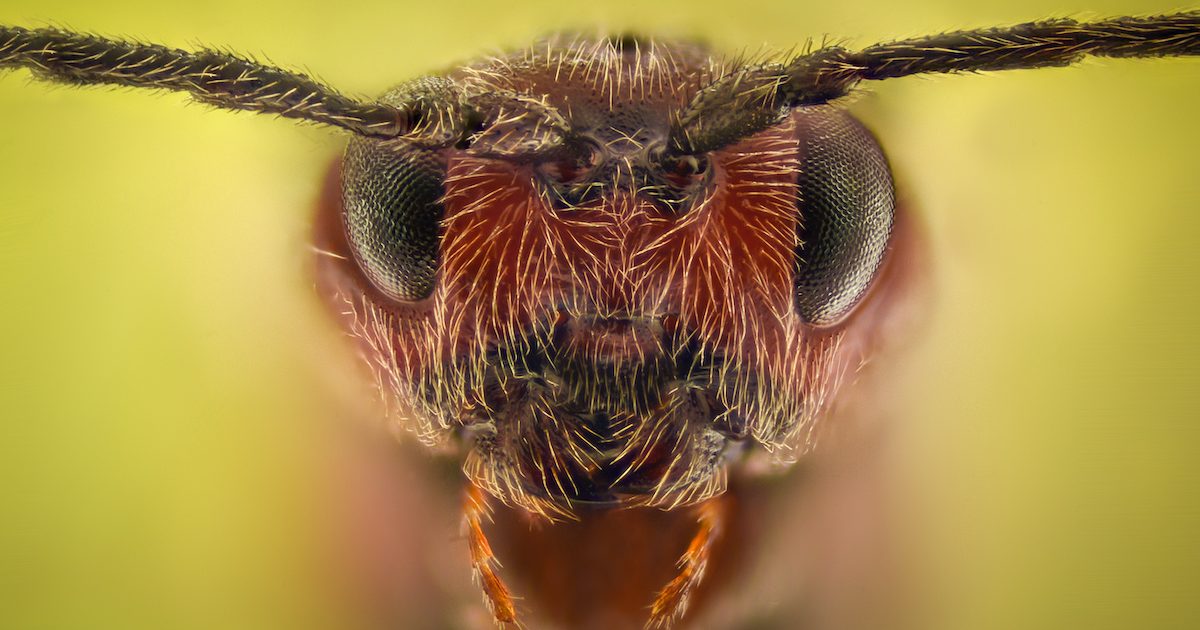
A great variety of ant species can be found in the Tampa Bay area, some of which prefer your home over the great outdoors. Ants are notoriously difficult to eradicate without professional pest control. Tiny as they may be, an infestation of carpenter ants or fire ants can quickly destroy property, infiltrate food storage, and cause health problems. At Drive-Bye Pest Control, we believe in educating our customers: The more you know about Florida ants, the better equipped you are at preventing an ant problem in your home.
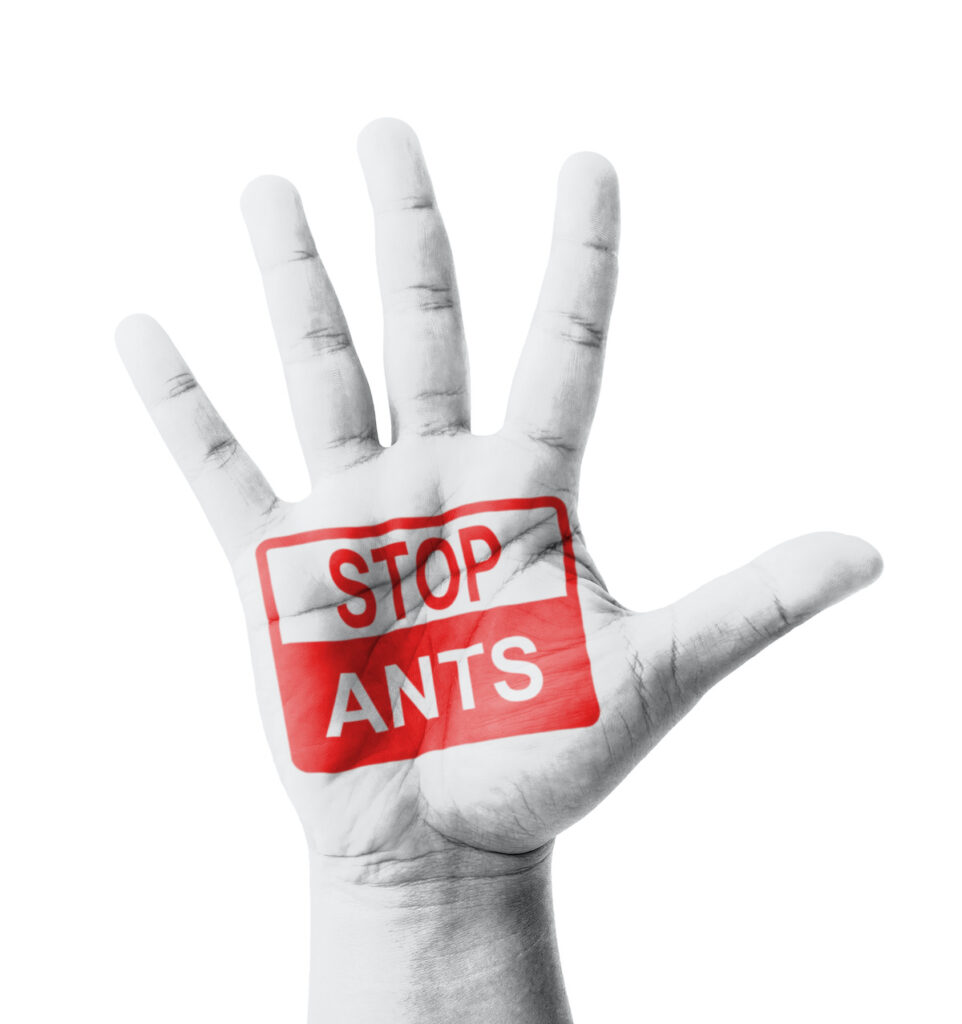 In our previous blog post about ants that commonly infiltrate Florida homes, we showed you how to identify Argentine, Acrobat, Ghost, and Pharaoh ants. We also reviewed a few important tips for how to deal with each of these species. In this post, we will cover two types of ants that are most troubling for southwest Florida home and business owners:
In our previous blog post about ants that commonly infiltrate Florida homes, we showed you how to identify Argentine, Acrobat, Ghost, and Pharaoh ants. We also reviewed a few important tips for how to deal with each of these species. In this post, we will cover two types of ants that are most troubling for southwest Florida home and business owners:
- Carpenter Ants
- Fire Ants (Red Ants)
Carpenter Ants
With nests numbering in the millions, the insidious carpenter ant is also probably the most well-known of ant species. They have voracious appetites, causing structural and cosmetic damage to the properties they invade. Carpenter ants do not eat wood as do termites; rather, they destroy wood by burrowing tunnels through the center. This weakens the wood structure from the inside. They quickly spread out into multiple, interconnected colonies leaving sawdust-like debris in their wake.
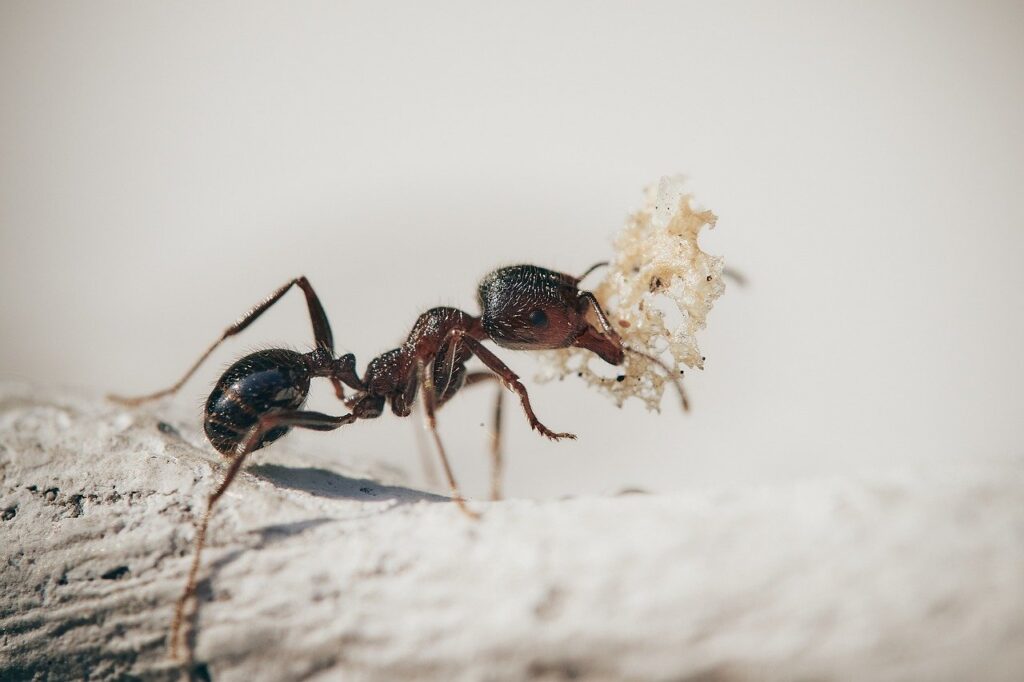
Characteristics of Carpenter Ants
- Body: well-defined segments with a large thorax and a large mandible for gnawing
- Size: the largest ant in the United States, ranging from 3.4 to 13 mm long
- Color: black to blackish-brown, also reddish-black or red/black in appearance
- Food: Carpenter ants ganw through and remove wood, depositing the debris outside of their nests in small piles. They eat “people food:” They especially like sweets and meats. They will also feed on other insects.
- *Sound* Unlike other ants, when you have enough carpenter ants you may hear a “rustling” sound as the ants go about their work within the home’s wood.
How did I get Carpenter Ants at my Property?
If you have left wood piles around your home and the wood has gotten wet, then you have invited carpenter ants to your property. If you have moisture damaged areas within the home, they are at risk for carpenter ant infestation. They burrow into the wet wood and begin establishing a nest. Additionally, carpenter ants are likely to nest in structural lumber such as in wall voids, hollow doors, windows and foam panels.
Signs of Carpenter Ant Infestation
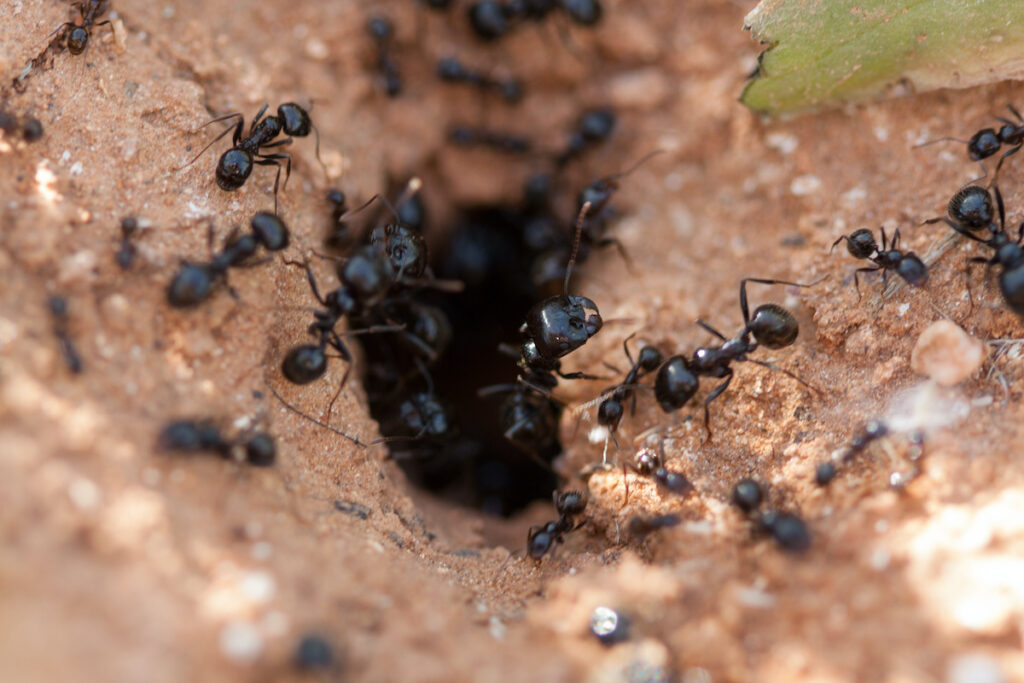
- Points of entry in the home where moisture and rain can enter the home are points of entry for carpenter ants. In addition to the “rustling” sound of carpenter ants busily gnawing wood, other signs of infestation include:
- Wood shavings (like pencil shavings) seen beneath wood structures in or around the home
- Wood shavings in the dirt where ants have carried wood to an outdoor nest
- Seeing large, winged ants emerge from ceilings, walls and crevices
Do I Have Carpenter Ants or Termites?
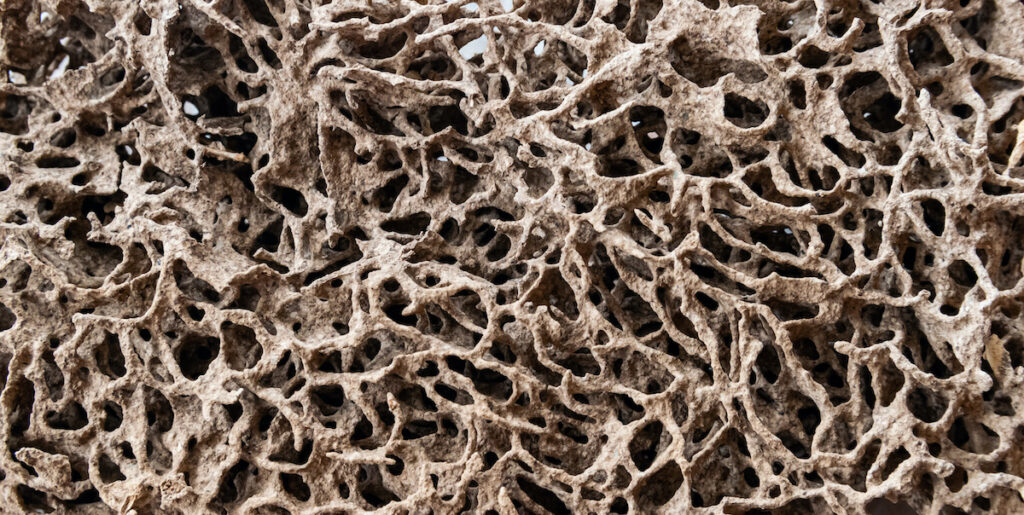 The key difference between termite infestation and carpenter ants infestation is the appearance of the destroyed wood. Carpenter ants don’t eat the wood, the tunnel through it in a very efficient way to create smooth, clean paths. Termites eat wood for nutritional value; the wood is destroyed and often there is dirt or mud caked in where the damage exists. Above, is wood damage from termites.
The key difference between termite infestation and carpenter ants infestation is the appearance of the destroyed wood. Carpenter ants don’t eat the wood, the tunnel through it in a very efficient way to create smooth, clean paths. Termites eat wood for nutritional value; the wood is destroyed and often there is dirt or mud caked in where the damage exists. Above, is wood damage from termites.
Two types of Fire Ants
 Not every red ant is a fire ant. Just when you thought red fire ants were enough for most Floridians to deal with, we are here to educate you about two types of fire ants.
Not every red ant is a fire ant. Just when you thought red fire ants were enough for most Floridians to deal with, we are here to educate you about two types of fire ants.
The ants known for their painful bite and venomous sting are properly known as the Red Imported Fire Ant (RIFA). And, we also have the Black Imported Fire Ant (BIFA). The difference between the two types of ants is this:
- The RIFA is largely red except for the black abdomen.
- The BIFA is primarily black to brownish-black.
The good news is the BIFA can live in Florida, but prefers the climate of Texas, Mississippi, and Tennessee. The RIFA prefers Florida, Georgia, and the Carolinas, and can thrive throughout the Southeastern United States..
Characteristics of Fire Ants
- Body: reddish except for the black abdomen with noticeable stinger.
- Size: tiny, by ant size standards
- Color: blackish; reddish; sometimes copper-colored head
- Food: live insects, dead animals; in the home: fats, sweets
The Fire Ant Bite
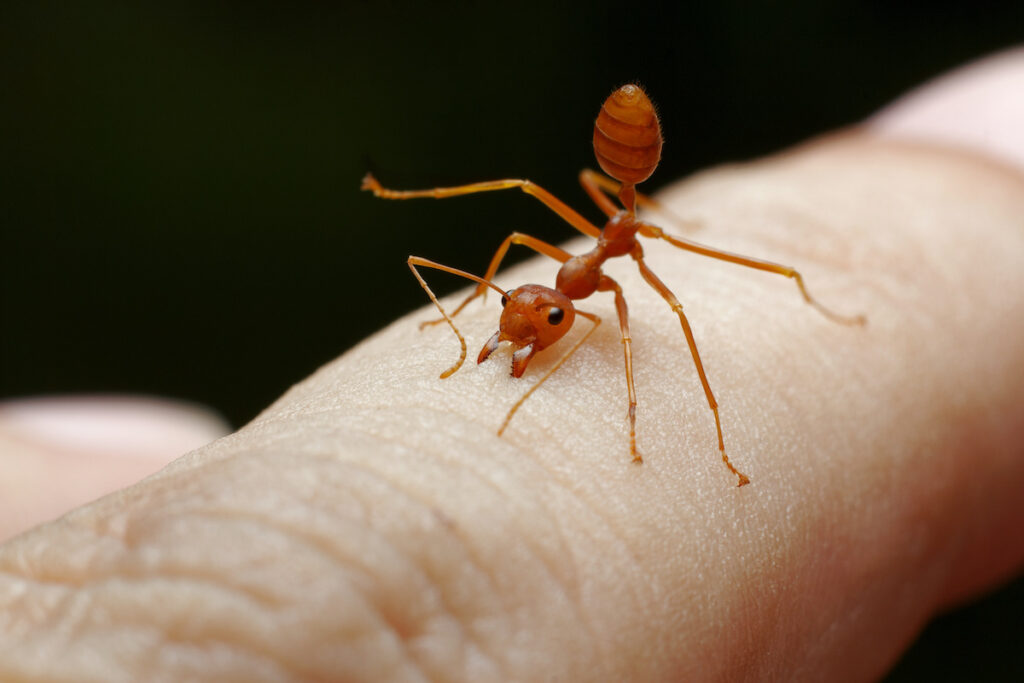 Fire Ants latch on with their sharp mandible (the bite) and then inflict a painful sting that injects and alkaloid venom into the “victim.” This combination of bite and sting is intensely painful. The venom produces a burning sensation combined with red welts and pustules. Some people can experience an allergic reaction; fatalities have been documented as a result of fire ant stings.
Fire Ants latch on with their sharp mandible (the bite) and then inflict a painful sting that injects and alkaloid venom into the “victim.” This combination of bite and sting is intensely painful. The venom produces a burning sensation combined with red welts and pustules. Some people can experience an allergic reaction; fatalities have been documented as a result of fire ant stings.
Because Fire Ants are such a risk to young children as well as adults who may be allergic, we will be covering fire ants in detail in our next blog post. Right now, we want to educate you about identification of infestation and what NOT to do if you suspect you have a fire ant problem at your Tampa Bay home or office.
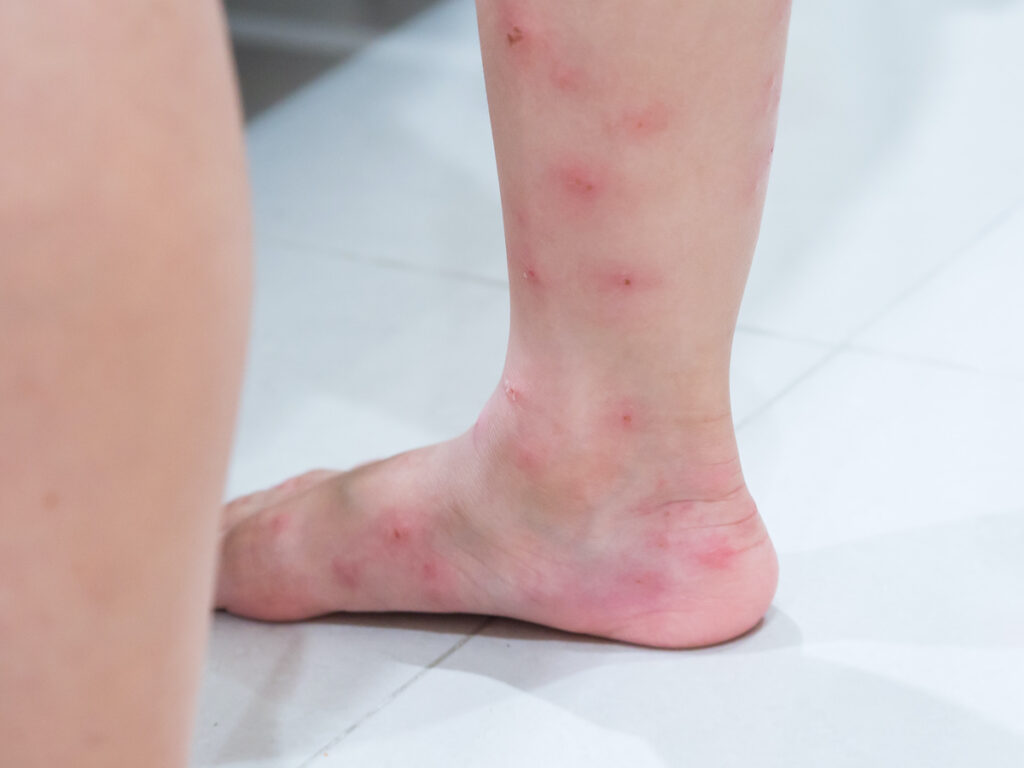
Signs of Fire Ant Infestation
The most obvious indication of a problem is when your child comes running into the house screaming “Get them off! Get them off!” You may see a few ants still crawling on the skin, but if you don’t you will recognize the bites by the pustules and rash like pattern. Fire ants attack in vast numbers, increasing the likelihood of numerous stings.
Please refer to this video resource for treating fire ant stings.
You’ll want to put on long pants, tucked inside your socks and boots, and venture into your yard. Keep in mind: Fire ants are least active during the hottest hours of the day. They avoid darkness and shade. You are less likely to intrude upon an active colony if you look around during midday, rather than when the colony is bustling with activity. These are aggressive ants! You want to look around when it is safest for you to do so. If you know you are allergic, do not do this yourself. Call in a professional pest control service to identify red ant nests on your property.
- Soil mounds in sunny areas, in open fields and lawns.
- Mating Flights. Winged male and female “reproducers” take to the air in massive numbers to mate and establish new nests. Males die after mating.
- Nursery Plants. Did you ( or your neighbors) recently buy new sod or plants? Look them over carefully, it is likely the fire ants were transported to your property that way.
Fire ants can spread across neighboring lawns, so speak with neighbors about the problem.
Getting Rid of Fire Ants Requires Professional Pest Control
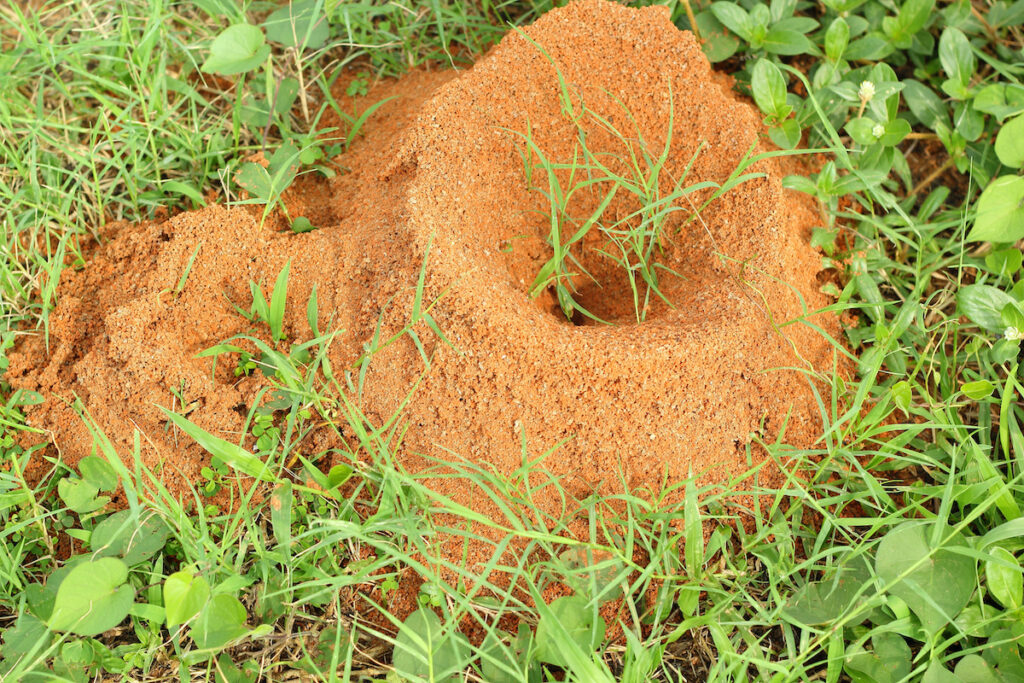 Fire ants are incredibly difficult to eradicate because the colonies are very large and extend under the ground a great distance. Additionally, fire ants often have multiple queens, which allows them to recover quickly if a part of the colony or other queens have been killed. With numbers in the hundreds of thousands per colony, the chances are high that when you have eliminated one colony another will move into the space.
Fire ants are incredibly difficult to eradicate because the colonies are very large and extend under the ground a great distance. Additionally, fire ants often have multiple queens, which allows them to recover quickly if a part of the colony or other queens have been killed. With numbers in the hundreds of thousands per colony, the chances are high that when you have eliminated one colony another will move into the space.
Home Remedies for Fire Ants are Not Effective
You may have read that orange oil will keep fire ants away. For a time, it may. The odor is noxious to fire ants. However, it will not kill them and they will find a way around the oil.
Likewise, boric acid can be used against fire ants, but if it is not applied correctly, you can make things worse. Boric acid may kill the ants that come in contact with it, but if it doesn’t get back to the nest, all you’ve done is reduce a small portion of the colony and not killed the root problem. Also, boric acid is not something you want your pets or children to get into.
Pest Control & Eradication Done the Right Way

You may have heard the saying, “the ants you see are not the only ants you’ve got.” Visible ants are often a tiny fraction of the population living on your property. Some ant species also are indicators of other types of pest problems.
When you call in a pest control service, you want the pest evaluation and plan of action to be done right. Drive-Bye Exterminators are experienced technicians who understand the behavior of ants and other pests that are common to Clearwater, St. Pet, and Tampa. We begin with a thorough inspection of your home and property not just to identify the ants, but to get to the underlying causes that are attracting them to your home and outdoor areas. Contact us today for a free estimate and a thorough inspection of your property.
Additional Resources
University of Florida Extension Program






